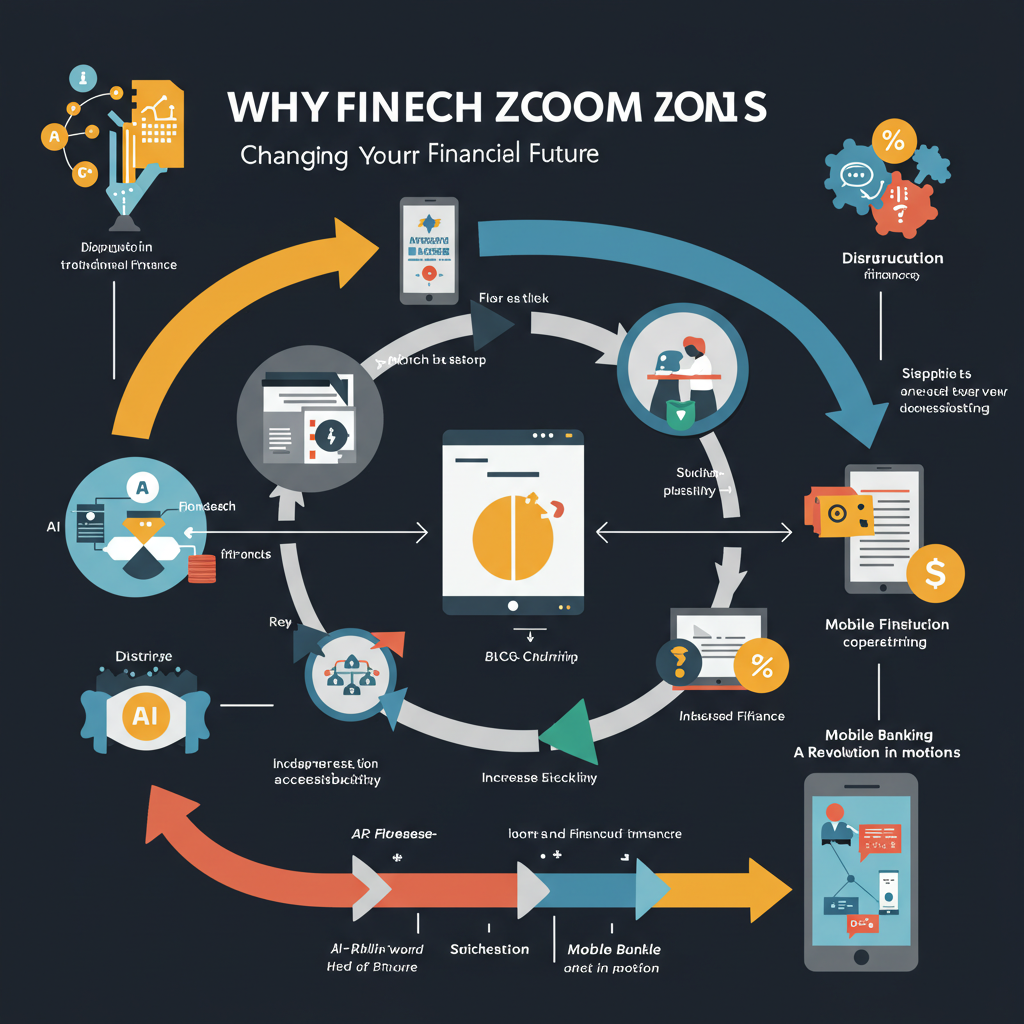In the fast-evolving world of technology and finance, few names spark curiosity and innovation quite like Fintech Zoom. While it may not be a household term yet, this rising digital force is transforming how people interact with money, make investment decisions, and seek financial advice. Unlike traditional financial institutions that often rely on legacy systems and outdated protocols, fintech platforms like this one are nimble, intelligent, and built for the needs of the modern user.
In this article, we’ll uncover how the evolution of fintech platforms is redefining financial literacy, accessibility, and trust. We’ll also explore how security, innovation, and personalization are converging to shape your financial future quietly, powerfully, and irreversibly.
1. The Rise of Fintech: A Revolution in Motion
The word “fintech” itself is a blend of “financial” and “technology.” Over the last decade, fintech companies have grown from disruptive startups into powerful players capable of shaking up the entire financial industry. The traditional financial model relied on banks, insurance companies, and brokerage firms to control access to services. But fintech platforms bypass these gatekeepers, giving users direct access to digital financial solutions with fewer barriers and more benefits.
Today, platforms offer everything from real-time data on markets to personalized financial advice generated through AI. They’re not just about ease, they’re about empowerment.
2. The Shift from Traditional to Digital: What’s Driving It?
A significant reason behind the success of fintech platforms is accessibility to financial services that were once difficult to navigate. Think about the early 2000s, opening a bank account meant waiting in line, filling out forms, and waiting days for approval. Today, it takes five minutes and a selfie.
This shift is driven by three major trends:
-
Digital Currencies: With the rise of cryptocurrencies and blockchain-based payment systems, money itself has become digitized. Platforms now offer seamless crypto trading, lending, and storage.
-
Mobile-First Design: Every modern fintech app is user-friendly, putting the entire financial world in your pocket.
-
Machine Learning Algorithms: These allow platforms to offer personalized financial advice based on spending behavior, risk appetite, and future goals.
Fintech is no longer just about sending money, it’s about reshaping how we think of money entirely.
3. Market Trends: Navigating the Noise
In a world flooded with information, identifying real market trends can be overwhelming. That’s where modern fintech shines. Platforms use AI and real-time data analytics to track thousands of data points per second, making sense of volatility and delivering insights that matter.
Users get clear visual dashboards that display:
-
Stock market trends
-
Currency fluctuation signals
-
Alerts for major financial events
-
Historical data analytics
This makes investment decisions smarter and more informed—no more relying on guesswork or hype.
4. Security Measures: Building Trust in a Digital Age
One of the largest hurdles fintech platforms have overcome is security. Consumers are naturally cautious about where they store their financial data and how it’s used. But new-age security measures are now more sophisticated than ever.

Key technologies include:
-
End-to-end encryption of all transactions
-
Biometric verification, like fingerprint and facial recognition
-
Two-factor authentication for login and fund transfers
-
Real-time fraud detection algorithms that monitor behavior
The integration of blockchain technology adds another layer of security, ensuring that transactions are immutable, transparent, and secure from tampering.
5. Peer-to-Peer Finance: The Social Side of Fintech
Remember when lending money meant going through banks or shady personal loan schemes? Today, peer-to-peer (P2P) platforms are disrupting this narrative. They allow individuals to lend or borrow money directly from one another, often at better interest rates and with more flexible terms.
This system:
-
Reduces intermediaries
-
Increases trust through transparent ratings
-
Promotes community-led financial empowerment
P2P isn’t just efficient, it’s personal.
6. Fintech Innovation: Beyond the Buzzword
What truly sets this industry apart is its commitment to fintech innovation. Each month brings new tools and services that redefine the boundaries of what’s possible.
Innovations include:
-
AI-powered robo-advisors that craft tailor-made portfolios
-
Digital wallets that integrate crypto, fiat, and NFTs
-
Virtual banks with no physical branches but complete services
-
Voice-command financial tools that allow users to manage funds hands-free
These developments are not gimmicks. They’re redefining customer expectations and pushing even traditional banks to evolve or risk extinction.
7. The Personal Touch: Custom Financial Solutions
A unique feature of modern platforms is their ability to craft personalized financial solutions. Unlike one-size-fits-all banking models, fintech platforms analyze a user’s financial behavior in real time to tailor strategies that work for them.
This means:
-
Better saving strategies
-
Intelligent budgeting
-
Alerts to prevent overdrafts
-
Goal tracking for big life milestones
With this level of personalization, even users with minimal financial literacy can make empowered choices.
8. Real-Time Financial Transactions: The Need for Speed
Speed is the new currency. In today’s fast-paced world, users expect everything instantly, including their financial transactions. Gone are the days of waiting 2-3 business days for a money transfer to complete.
Now:
-
Payments are processed in real time
-
International transfers happen within minutes
-
Notifications are sent instantly
-
Accounts are updated the moment a transaction occurs
These features dramatically enhance user experience and trust, especially in critical moments like emergency payments or trading deadlines.
9. Enhanced User Experience: Design Meets Intelligence
Fintech platforms succeed not only because of their intelligence but also due to their design. They’re built to be intuitive, visually appealing, and emotionally reassuring.
Key design elements include:
-
Clean interfaces with minimal clutter
-
Interactive visualizations of spending and investing
-
Guided tutorials for new users
-
Gamification to make financial literacy fun
A well-designed experience enhances user experience and ensures adoption even among tech-averse users.
10. Financial Data as the New Oil
In fintech, financial data is more than just numbers—it’s a goldmine of insight. Platforms are now using machine learning and big data analytics to:
-
Predict spending habits
-
Identify fraud risks
-
Forecast market behavior
-
Recommend products and services
The smarter the platform, the better it gets over time. With more user input, AI engines learn to serve users better, ultimately making finance more human.
11. The Human Element: Emotional Intelligence in Fintech
Surprisingly, what makes these platforms powerful isn’t just their digital nature; it’s their emotional awareness. Modern platforms now consider:
-
Financial stress levels
-
Emotional spending triggers
-
Behavioral finance principles
This means users are not just guided logically but also emotionally, leading to healthier long-term financial decisions.
Some apps now include:
-
“Emotion-aware” chatbots
-
Spending limit warnings triggered by mood analysis
-
Daily check-ins to track emotional well-being alongside budget adherence
12. Future Outlook: Where Is Fintech Headed?
Looking ahead, the future of fintech will revolve around even deeper integration of finance into daily life. The next wave will likely feature:
-
Wearable fintech: Smartwatches and rings that make payments or alert you to spending habits
-
Augmented reality banking: Visualizing your portfolio in 3D environments
-
AI financial therapists: Guiding users through anxiety around money
-
Universal wallets: Unifying crypto, fiat, loyalty rewards, and points into a single digital identity
With these advancements, the line between finance and lifestyle will blur completely. Money will not be something you manage—it will be something that flows with your life seamlessly.
A Financial Renaissance Is Here
In a world where the traditional financial model has long been the norm, fintech platforms are offering something different: speed, intelligence, security, and empathy. They’re not just digitizing finance; they’re humanizing it.
And while many still view platforms like Fintech Zoom as niche or experimental, the truth is more profound. They are the quiet architects of a new financial future, one that puts you at the center.



